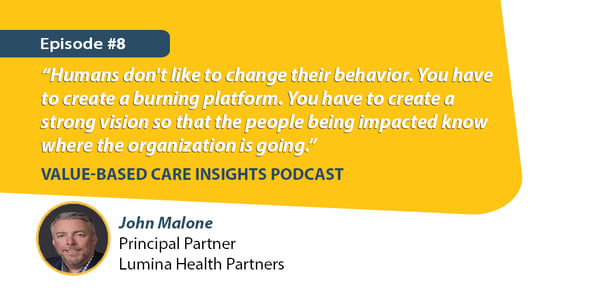Episode Overview:
Managing Principal Daniel J. Marino and Managing Principal John Malone discuss why it is important for organizations to focus on clinical variation strategies to manage and reduce the cost of operations. John shares various data-driven approaches to manage variation in processes, training and operations that lead to decreased costs across lines of service.
Organizations that have been successful in reducing costs found that they have not only delivered better patient care, but their operations are more efficient. Managing clinical variation helps make the team and physicians more effective. When that happens, there is a strong opportunity for the organization to change. These organizations have an excellent top-down approach that is supported by strong communication.
Co-hosts:

Daniel J. Marino, Managing Partner, Lumina Health Partners

Shaillee Chopra, Principal, Lumina Health Partners
Guest:

John Malone, Principal, Lumina Health Partners
Episode Discussion Areas:
1. What is clinical variation? How does it help to improve the delivery of patient care?
- Clinical variation is a hot topic as it aims to reduce operating costs and improve margins be addressing the overuse or underuse or different use of healthcare services.
- CVR is a new frontier of margin improvement.
- CVR works in a fee-for-service environment and in a fee for value-based world.
2. Where do organizations start as they think about approaching clinical variation reduction?
- Great granular analytics that identify where variation is occurring and where to target improvement efforts.
- Strong physician participation - it is critical to have buy-in.
- Organizational change management - humans don’t like to change behavior so a burning platform needs to be identified to help people know where the organization is going, coupled with a strong strategic plan.

9 Key Takeaways: Clinical Variation Reduction
1. Clinical variation reduction has been gaining popularity because there has been a lot of effort around reducing operating costs, so as to improve margins.
- Many organizations have already addressed the low hanging fruit of improvement programs and are now looking for other ways to improve their margins.
2. Clinical variation reduction is surfacing as the next frontier in margin improvement.
- It has the distinct advantage of being focused on cost reduction, revenue improvement and quality improvement. You could attack all three of those target areas simultaneously.
3. Providence Healthcare and Methodist Le Bonheur Healthcare have been successful in clinical variation reduction efforts.
- Providence focused on perioperative services. Methodist reduced costs by close to $800,000 by implementing stronger processes to reduce clinical variation.
4. There are three critical success factors to successfully driving a clinical variation reduction program.
- Granular analytics. By pulling together data from across the organization into one platform, you identify where and how much variation is occurring and where to target your improvement efforts.
- Strong physician participation. Physician engagement in these efforts is critical.
- Organizational change management. You must have an effective plan that you can articulate.
5. One academic organization spent 20 to 30 percent of their day on unnecessary meetings.
- Clinical variation reduction solves inefficiencies such as unnecessary meetings and makes the team much more effective.
6. If you have a strong physician leader who has a vision for improving care delivery and reducing variation, you start to see improvements.
- You could start small, but it does significantly contribute to improvement.
7. There are several buckets of improvement opportunities that clinical variation programs typically uncover.
- From a cost perspective, savings opportunities may exist by reducing resource consumption.
8. Some facilities are at full capacity.
- If they can both improve throughput [through clinical variation reductions] and [take in] more patients, there's potentially a very significant impact on additional revenue.
9. The trend of physicians becoming employed creates opportunities for new and unique incentives.
- Value-based programs, including the Medicare Shared Savings Program and episode-based programs are all designed to create more effective financial and quality results that yield savings that can be shared across the medical staff.
Resources mentioned:
- Healthcare Leadership Alliance
- HealthPartners
- Institute for Healthcare Improvement
- Journal of the American Medical Association
- Memorial Care
- Methodist Le Bonheur Healthcare
- Modern Healthcare
- Providence Health
About Value-Based Care Insights Podcast
Value-Based Care Insights is a podcast that explores how to optimize the performance of programs to meet the demands of an increasing value-based care payment environment. Hosted by Dan Marino and Shaillee Chopra, the VBCI podcast highlights recognized experts in the field and within Lumina Health Partners.





Share this: